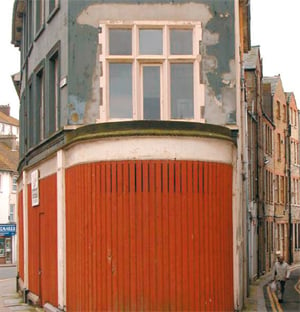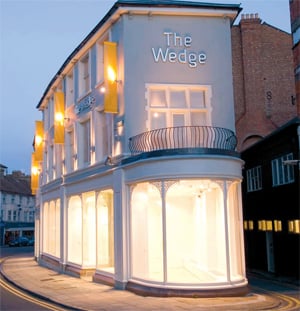Folkestone resurgent
The Creative Foundation places the arts at the heart of the regeneration of Folkestone, writes Nick Ewbank


Folkestone and the surrounding Kent coastline have long been a centre of creativity, attracting the likes of Marcel Duchamp, H G Wells, Edith Nesbit, Charles Dickens, John Logie Baird, Agatha Christie, Derek Jarman, Jimi Hendrix, Samuel Beckett and George Bernard Shaw at various times in history. A ferry service used to connect the town with Boulogne, and this, combined with the outstandingly attractive location, led to the development of Folkestone as a fashionable resort in the late nineteenth and early twentieth centuries. The advent of foreign package holidays and cheap air travel in the 1960s led to a steep decline in tourist numbers. At the same time, the town’s fishing fleet was drastically reduced in size. The ferry link with Boulogne was severed after the opening of the Channel Tunnel in 1994, and symbolically, Folkestone disappeared from many road signs. Many areas of the town began to suffer from severe social and economic problems, with above average unemployment, and high levels of unfit housing, single-parent families and health deprivation. More affluent areas of the town were increasingly characterised by an ageing population, and many younger people began to see their future prospects as being away from Folkestone. Consequently, the social fabric of the town began to fragment.
Failing fortunes
In 2002, the Creative Foundation was established as a charitable enterprise to develop a strategy to reverse Folkestone’s failing fortunes. With Roger De Haan, philanthropist and former owner of Folkestone’s largest employer, Saga, as Chairman, we worked to bring together key local bodies and to develop a radical vision for the town. This vision goes further than many previous models of arts-led regeneration in placing the arts at the heart of every aspect of the process. Our strategy draws together cultural activity, economic growth, educational transformation and significant enhancements to the built environment, thereby to deliver dramatic improvements to the local quality of life and the way the town is perceived externally. More than 200,000 square feet of property are now controlled by the Creative Foundation, spread across the historic Old Town, now rebranded the ‘Creative Quarter’. Of these, 40 properties have been restored and leased to 150 creatives at sustainable prices. As we progress with our £35m refurbishment programme, we expect several hundred more jobs to be created, which will help to reinvigorate the town through a new creative economy. Effectively, we have established a model of social enterprise that can operate within the framework of a charity.
Educational back-up
Several other linked projects are also underway. These include broader education initiatives such as University Centre Folkestone, a joint venture between Canterbury Christ Church University, the University of Greenwich and the Creative Foundation, which will eventually provide arts and creative industry-related higher educational courses for 1,500 students. A new City Academy specialising in arts, media and European culture has replaced an under-performing secondary school, and Kent County Council’s adult education provision has moved to custom-converted premises in the Creative Quarter. Pioneering research into the links between arts and well-being, particularly the potential of singing to have a impact on dementia care, is taking place within University Centre Folkestone, as part of Canterbury Christ Church University’s Sidney De Haan Research Centre for Arts and Health.
Folkestone lacks cultural facilities, and Quarterhouse, the Creative Foundation’s new 250 seat/500 standing capacity performing arts centre, will open in early 2009. It will provide a platform for the promotion and production of high quality music, theatre, dance, comedy and other events for local audiences. This month sees the Creative Foundation’s annual Folkestone Literary Festival, which is being established as one of the literary world’s leading events, and plans are being made to initiate a range of new festivals on a year-round basis. This summer we inaugurated the Folkestone Triennial, a contemporary visual arts exhibition designed to engage, entertain and inform both the existing community and newcomers to the region. Twenty-two major art projects were commissioned from artists such as Tacita Dean, Tracey Emin and Mark Wallinger. The town itself served as a canvas to create new works that interact with Folkestone’s people and their environment, history and culture. As well as attracting tens of thousands of visitors from outside the town, the Triennial introduced the work to a whole new audience. Each Triennial will include a number of permanent works, so that Folkestone will become a year-round centre for contemporary art.
Aiming for change
In recognition of our approach to transforming a whole community through culture, the arts and education, the Creative Foundation, in partnership with Kent County Council, has recently been awarded one of the ten national pathfinder projects for the government’s ‘Find Your Talent’ programme. This entrusts the Creative Foundation with responsibility for delivering five hours a week of high quality cultural experience to all 23,000 young people living within the Folkestone district. This is a compelling challenge, as it will be the true test of our proposition that engaging fully in cultural experiences can bring important changes to people’s lives and to the communities in which they live. Many people working in the arts are cynical about the sometimes overblown claims made for the potential of the arts to contribute meaningfully to regeneration. In Folkestone we are getting on with it, striving to ensure that the highest standards of artistic excellence are matched by genuine access and engagement for the whole community. Folkestone is in a process of rapid change. The new high speed rail service to London opens in December 2009 and will cut journey times to just one hour (a reduction of around 40 minutes), and, despite the current economic downturn, this should bring a new wave of energy and prosperity to the town. Our success over the next few years should empower local people to rise to the challenges of their changing environment and make the most of their opportunities in a resurgent Folkestone.
Join the Discussion
You must be logged in to post a comment.